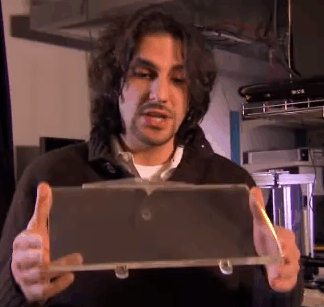| Kinect plus a glass wedge gives ... |
| Monday, 28 February 2011 | |||
|
New display technologies use a simple glass wedge and a Kinect to bring you touchless touchscreens and 3D without glasses.
There is a Simpsons episode where an inanimate carbon rod wins the "worker of the week award" much to Homer's irritation. You could say that the hero of much of the work at Microsoft's Applied Sciences Group is an inanimate glass wedge. This simple piece of optics is being used in a number of different smart screen designs to do things that until recently seemed too difficult. The wedge acts as a simple light guide which allows either a TV camera to see a view without getting in the way or a bank of LEDs to project a view without getting in the way.
The first application (shown in the video) is just a 3D position sensor that allows you to draw on a screen without actually touching it. You can think of it as a no-touch touch screen if you like. The second application is probably more impressive and more exciting. Using the glass wedge the system can steer beams from LEDs to a fixed point in space. The clever part is that using this one image can be sent to the left eye and another to the right eye. Of course, and you were probably waiting for this, the head tracking necessary is performed by a Kinect camera. So a simple glass wedge plus a Kinect give you 3D display that needs no glasses to be worn and isn't as difficult to create as a real time hologram. There is also a version of the application that shows two different images to each of two people - although it is harder to see a mainstream use of this particular demo. Finally we have a sort of synthesis of an augmented reality window. A screen that lets you peer through it as if it was a window onto a real scene - well it is Microsoft so you knew Windows would come into it somewhere.
What is really amazing is that the Kinect makes it all possible. Each time you see a new and impressive demo there seems to be a Kinect somewhere. More Informationhttp://www.microsoft.com/appliedsciences/content/projects/wedge.aspx
|
|||
| Last Updated ( Monday, 28 February 2011 ) |

